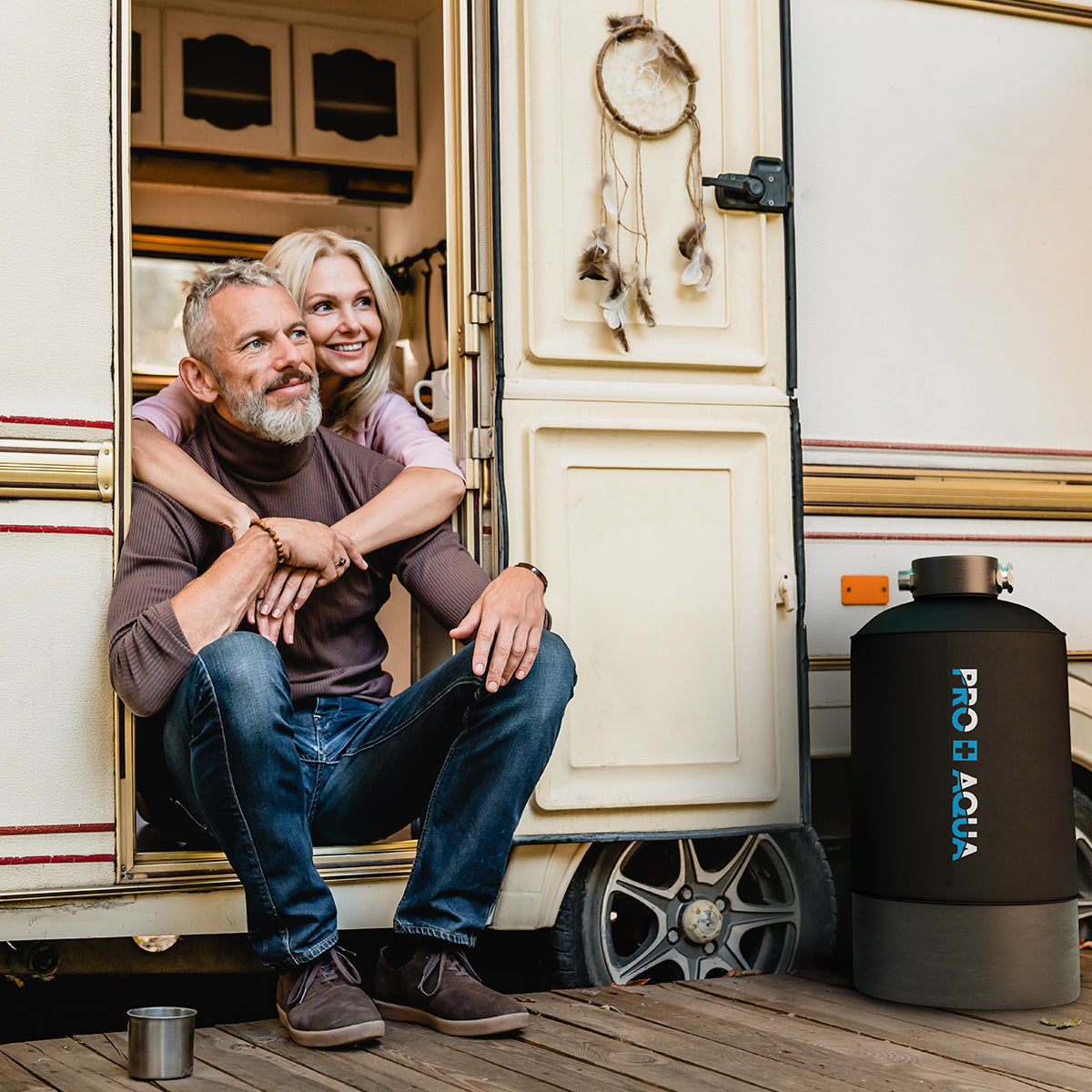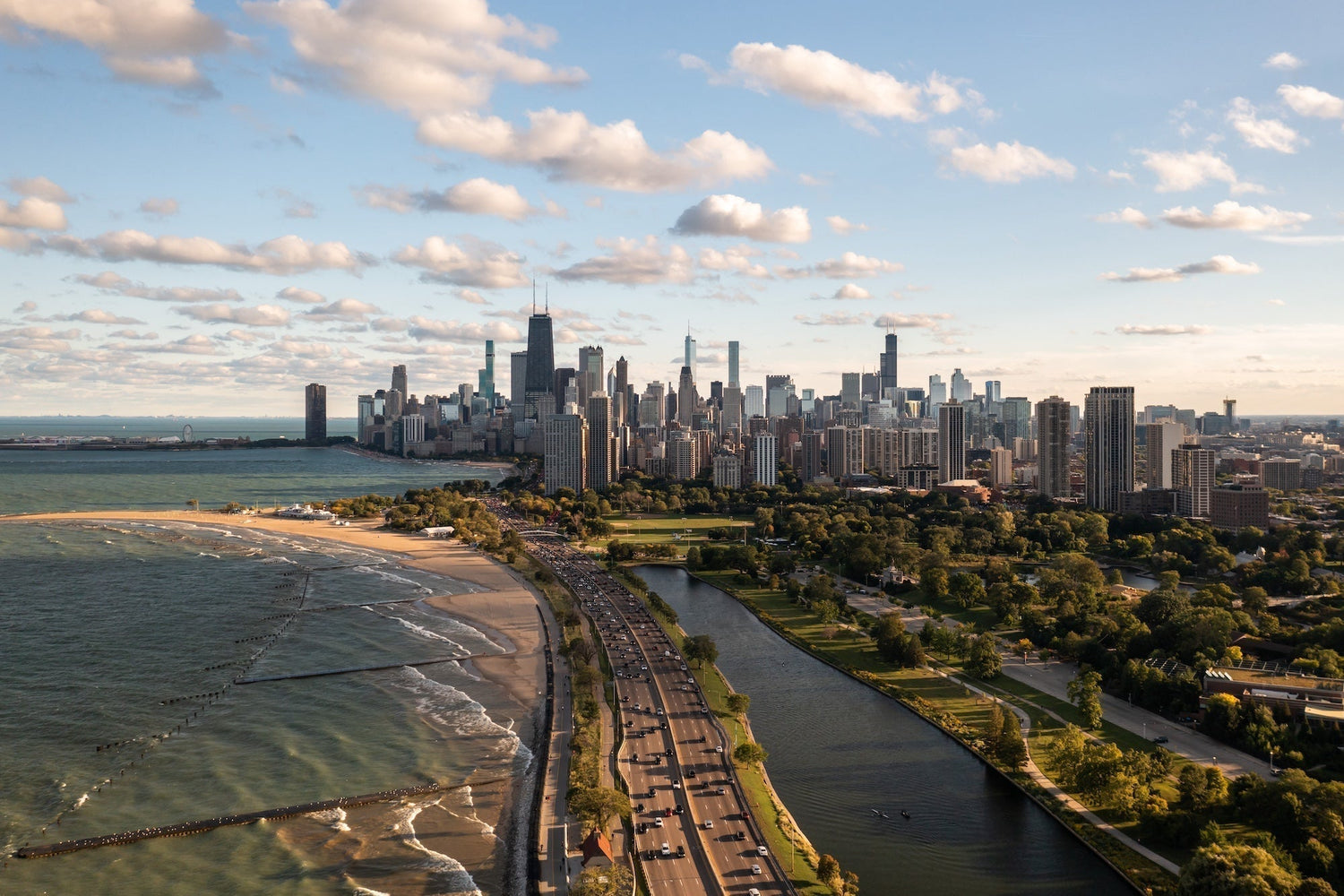If you live in Chicago, IL, chances are you’ve wondered: Is tap water safe to drink in Chicago?
From Northalsted to South Shore Lake Drive, residents are paying closer attention to what flows from the tap. And for good reason.
Chicago tap water meets all state and federal safety standards, but “legally safe” doesn’t always mean “risk-free.”
In this guide, we’ll break down Chicago water quality using the city’s 2024 water quality report, what the Environmental Working Group (EWG) found beyond the official reports, and how you can protect your home with the right filtration.
01 | Who Regulates Chicago’s Drinking Water

Three agencies oversee what ends up in your glass:
- Federal: The U.S. Environmental Protection Agency (EPA) enforces the Safe Drinking Water Act and sets enforceable contaminant limits under the National Primary Drinking Water Regulations.
- State: The Illinois Environmental Protection Agency (Illinois EPA) enforces state-specific standards and monitors emerging contaminants such as PFAS.
- Local: The City of Chicago Department of Water Management (Chicago DWM) draws, treats, and monitors water from Lake Michigan and publishes annual consumer reports.
Together, these agencies create a multi-layered oversight chain. Yet not every contaminant has an enforceable federal limit, meaning some substances are still monitored but unregulated.
02 | Where Does Chicago Get Its Water

Chicago draws its drinking water entirely from Lake Michigan, one of the largest freshwater lakes in the world. The city operates two massive treatment plants:
- Jardine Water Purification Plant, serving downtown and the North Side
- Eugene Sawyer Water Purification Plant, supplying the South Side and nearby suburbs
According to the DWM, every drop drawn from Lake Michigan follows a precise, multi-stage purification process before it reaches your tap.
Water from Lake Michigan enters offshore intake cribs at depths of 20 to 30 feet, then travels through tunnels beneath the lake bed into the intake basins of the Jardine and Sawyer Water Purification Plants. From there, the process unfolds as follows:
- Screening & Initial Lift: Water passes through eight traveling screens that trap large debris before low-lift pumps raise it roughly 25 feet for its first chemical treatment.
- Coagulation Water Treatment: Coagulant chemicals are added in mixing basins to bind fine particles into larger clusters. This marks the beginning of the flocculation process, where tiny solids start clumping together.
- Flocculation: The chemically treated water flows through large, slow-mixing basins that keep it gently in motion, allowing suspended particles to collide and form denser clumps of particles.
- Sedimentation Water Treatment: Flocculated water passes into settling basins, where the denser clumped particles sink to the bottom and are removed over several hours.
- Filtration: Clarified water is filtered through layers of precisely graded sand and gravel that perform a natural polishing, removing remaining suspended matter and microorganisms.
- Final Treatment: In clearwells, the filtered water receives its final applications: disinfection with chlorine, fluoride for dental health, and lime for corrosion control.
- Distribution: Finished water flows from the reservoirs into the citywide distribution system that serves more than five million residents.
Each stage plays a vital role in safeguarding Chicago’s drinking water, combining mechanical filtration, chemical precision, and corrosion control to deliver consistent quality from lake to tap.
03 | Chicago’s Annual Water Quality Report

Each year, Chicago publishes its Consumer Confidence Report (CCR), summarizing contaminants detected in the city’s supply.
The 2024 CCR confirms that Chicago met all federal and state drinking water standards, but some substances were still detected at trace levels below regulatory limits.
Select 2024 Findings (City of Chicago CCR)
|
Contaminant |
Detected Level |
MCL (Legal Limit) |
Health Concern |
|
Total Trihalomethanes (TTHMs) |
26 ppb avg |
80 ppb |
Disinfection by-product linked to bladder cancer |
|
Haloacetic Acids (HAA5) |
12 ppb avg |
60 ppb |
Cancer and developmental risks |
|
Nitrate (as Nitrogen) |
0.3 ppm |
10 ppm |
Fertilizer runoff linked to thyroid and infant health issues |
|
Barium |
45 ppb |
2,000 ppb |
Cardiovascular and kidney effects |
|
Lead (90th percentile) |
9 ppb |
15 ppb action level |
Neurological damage, especially in children |
While the report confirms compliance, it also reinforces that “not detected” doesn’t mean “not present.” It only means that levels were below the reporting threshold.
04 | What the EWG Found in Chicago’s Water

Chicago’s official report paints a reassuring picture. But independent testing by the Environmental Working Group (EWG) tells a different story.
According to EWG’s 2024 Tap Water Database, 20 contaminants were detected, and 13 exceeded EWG’s health-based guidelines. These guidelines are far stricter than federal MCLs, reflecting current toxicology research.
EWG Highlights (2024 Chicago Utility ID IL0316000)
|
Contaminant |
Detected Level |
EWG Guideline |
Exceeds by |
Health Concern |
|
Total Trihalomethanes (TTHMs) |
25.7 ppb |
0.15 ppb |
171× |
Cancer risk |
|
Haloacetic Acids (HAA5) |
11.7 ppb |
0.1 ppb |
117× |
Developmental effects |
|
Chromium-6 (hexavalent) |
0.19 ppb |
0.02 ppb |
9.5× |
Carcinogen |
|
Nitrate |
0.30 ppm |
0.14 ppm |
2× |
Cancer & thyroid issues |
|
Radium-226/228 |
0.89 pCi/L |
0.05 pCi/L |
18× |
Bone cancer risk |
EWG concludes that while Chicago’s tap water is legal under current regulations, it still contains contaminants at levels that may pose long-term health concerns.
05 | Top Contaminants Threatening Chicago Water Quality

Here are the primary contaminants affecting Chicago’s tap water and what they mean for you:
- Disinfection By-Products (DBPs): Formed when chlorine reacts with organic matter; linked to cancer and reproductive issues.
- Chromium-6: A toxic heavy metal associated with increased cancer risk even at low concentrations.
- Nitrates: Can interfere with oxygen transport in infants and disrupt thyroid function.
- Radium: Naturally occurring radioactive material that accumulates in bones.
- Lead: Most often introduced through service lines and indoor plumbing materials.
While all were below federal MCLs in 2024, most exceeded EWG health guidelines, showing the gap between legal limits and ideal safety.
06 | Health Risks of Contaminants in Chicago Water

Even trace amounts of contaminants can build up through years of exposure.
Health Concerns and Related Contaminants
|
Health Concern |
Associated Contaminants |
|
Cancer Risk |
TTHMs, HAA5, Chromium-6, Radium |
|
Thyroid & Developmental Issues |
Nitrate, HAA5 |
|
Neurological Damage |
Lead |
|
Immune System Disruption |
PFAS (if present below reporting levels) |
According to the EPA’s Health Advisories webpage, these health concerns reflect chronic exposure, not a single glass of water. Still, long-term risk reduction is worth the effort.
07 | Lead Found in Chicago’s Schools: Progress & Remaining Risks

Lead continues to be one of Chicago’s most stubborn water-quality challenges, especially in older school buildings where plumbing fixtures and service lines predate modern safety standards.
According to Chicago Public Schools’ Water Quality Testing Program, district-wide testing began in 2016, with a second comprehensive phase running from 2019 through 2023. The initiative focused on older facilities and early-childhood classrooms where younger students are more vulnerable to lead exposure.
CPS sampling follows a detailed testing protocol developed with the DWM and the Illinois Department of Public Health (IDPH). Any drinking fixture that tests above the district’s action level is immediately taken out of service, flushed, and retested before being returned to use.
An ABC 7 Chicago investigation from 2023 found that since 2019, roughly 1 in 10 fixtures tested by CPS exceeded IDPH’s 5 ppb action level. While the majority of samples fell below federal limits, experts agree that no level of lead is considered safe for children.
By the end of 2023, CPS had completed testing at all schools. It now conducts annual monitoring across roughly 25 percent of campuses each year through 2026. All test results remain publicly available on the CPS website.
In short, Chicago schools have made measurable progress. But continued vigilance, fixture replacement, and expanded testing remain essential for long-term safety.
08 | Treating Chicago Drinking Water at Home with Pro+Aqua
The solution isn’t waiting for policy. It’s protecting your own system. PRO+AQUA filtration systems deliver the performance and reliability your home deserves. But there are different types of water filtration systems that target different contaminants.
Whole-House Filtration & Softening: Whole-Home Confidence

Signs you need it: Hard water spots, dry skin, or mineral buildup on fixtures. Chicago’s water hardness averages 130 to 150 ppm (about 8 grains per gallon), which classifies it as hard water.
Featured System: PRO+AQUA PRO-E-S45E Whole House Water Filtration System + 45,000 Grain Water Softener Bundle
How it works: This complete two-in-one system combines the ELITE GEN2 PRO-100-E pre-filter with a 45,000-grain high-efficiency water softener to protect your entire home. The filtration stage removes chlorine, iron, sulfur, VOCs, lead, and sediment. The softener targets calcium and magnesium, the minerals responsible for scale buildup, keeping your plumbing and appliances clear and efficient.
You get:
- Whole-home water treatment with both filtration and softening
- Multiple grain capacity sizes to treat households of all sizes
- Premium high-efficiency water softener resin media to treat hard water
- Smart digital valve that optimizes salt and water use
- 3-stage water filtration system removes up to 99% of contaminants like chlorine, heavy metals, sediment, VOCs, & more
- Extends the lifespan of household appliances
Why it matters: The PRO-E-S45E delivers complete protection and lasting performance. It eliminates up to 99 percent of harmful contaminants while producing balanced, reliably soft water for every tap, shower, and appliance in your home.
Reverse Osmosis (RO) Systems: Pristine Drinking Water

Signs you need it: Concerns about lead, PFAS, chromium-6, or nitrates in your drinking water.
Featured System: PRO+AQUA 100 GPD 5-Stage Reverse Osmosis Water Filter System
How it works: This high-performance system uses a five-stage purification process that forces water through a fine semi-permeable membrane to remove up to 99 percent of dissolved contaminants. It is a point-of-use system designed to deliver pure, crisp, bottle-quality water straight from one tap.
You get:
- Ideal capacity for medium to large households, small offices, or businesses such as coffee shops and hydroponic setups
- Five-stage water filtration process that removes up to 99 percent of contaminants including lead, chlorine, heavy metals, and PFAS
- Compatibility with refrigerators, ice makers, coffee machines, and water dispensers
- A 6-gallon tank that provides twice the storage capacity of most standard RO systems
Why it matters: The 100 GPD 5-Stage Reverse Osmosis System represents the highest standard in home water purification. It delivers pure, great-tasting water that enhances your daily hydration and eliminates the hidden toxins found in untreated tap water.
Combined Filtration Bundle: The Complete Package

Signs you need it: You want whole-home protection combined with premium, purified drinking water at the tap.
Featured System: PRO+AQUA BNDL-WEL-RO 4-System Bundle
How it works: This advanced four-part water treatment system integrates the ELITE GEN2 PRO-100-E pre-filter, PRO-WELL-1E iron and odor filtration system, PRO-S-80E 80,000-grain water softener, and the PRO-UC-ROSTD 5-stage reverse osmosis system for complete protection. Together, they remove contaminants, eliminate hard water minerals, and produce ultra-clean drinking water throughout your home.
You get:
- A complete whole-home solution designed for households with three to four bathrooms on city, municipal, or well water
- Removal of up to 99 percent of contaminants, including sediment, VOCs, chemicals, chlorine, lead, hydrogen sulfide, and up to 7 ppm of clear-water iron and 2 ppm of manganese
- A reverse osmosis system that delivers purified water surpassing bottled water quality
- An 80,000-grain softener that reduces hardness minerals and prevents scale buildup
- Increased energy efficiency by protecting appliances, plumbing, and fixtures
- Commercial-grade design built with NSF-certified media and components for long-term reliability
- An advanced programmable digital metered control valve that cleans and regenerates only when needed, conserving salt and water
Why it matters: The BNDL-WEL-RO is the ultimate upgrade for families who expect more from their water. It delivers soft, clean, and safe water for every use in your home—from drinking and cooking to laundry, bathing, and even pet care. Engineered in California with commercial-grade durability, it defines what whole-home water confidence feels like.
09 | How to Test Chicago Water in Your Home

For true confidence, test what’s coming from your tap, not just city averages.
- Request a free lead test kit via Chicago 311.
- Schedule a home inspection through the Chicago Water Quality Program.
- Explore the Lead-Safe Chicago initiative for replacement and funding options.
At-home test kits can identify pH, hardness, and common contaminants like chlorine, lead, and nitrate, ideal for annual check-ups between city tests.
10 | Should You Use In-Home Water Filters in Chicago

Yes, and not just for taste. While Chicago’s water is legally compliant, EWG’s data show contaminants that exceed stricter health guidelines.
The EPA’s PFAS Rule and Drinking Water Health Advisories webpage both highlight emerging toxins that typical municipal systems can’t fully eliminate. Filtration is your line of defense for peace of mind.
Pro+Aqua systems target Chicago’s specific challenges from hard water minerals, heavy metals metals, PFAS, and more delivering long-term protection for your home.
11 | Solutions for Improving Chicago City Water Quality

Improving water quality starts both in your home and city-wide:
- Install a whole house filtration system that addresses Chicago-specific contaminants like lead and DBPs.
- Highly consider a drinking water system like a reverse osmosis filter system.
- Consider water softening to reduce scale buildup and protect appliances.
- Use the city’s Lead-Safe Chicago initiative for eligible residents and daycares.
- Stay informed through DWM alerts and EPA PFAS updates.
High-performance protection isn’t optional. It’s essential. Engineered for precision, built for confidence. Upgrade to PRO+AQUA.
FAQS
Is Chicago tap water safe to drink in 2025?
Yes, Chicago’s water meets state and federal standards. However, independent analyses show trace contaminants above stricter health-based guidelines. Many residents use home filtration for added safety and taste.
What are the main contaminants in Chicago drinking water?
TTHMs, HAA5, chromium-6, nitrate, radium, and lead are the most notable. Each falls within legal limits but above EWG health targets.
What does the EWG say about Chicago’s water?
EWG found 13 contaminants exceeding their own guidelines, including disinfection by-products and heavy metals. Their report stresses that “legal does not equal safe.”
Are Chicago schools addressing lead contamination?
Yes. CPS tests fixtures and replaces those above 5 ppb, stricter than federal requirements. The city also offers free lead testing for residents.
What’s the best way to filter Chicago tap water?
A combination of whole-house filtration, reverse osmosis drinking systems, and water softening provides comprehensive protection for hard water and contaminants.






Leave a comment
This site is protected by hCaptcha and the hCaptcha Privacy Policy and Terms of Service apply.